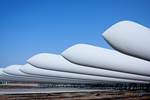Siemens Gamesa, Airborne develop automatic preforming robot system for offshore wind blades
Danish-funded ALMA project furthers collaboration, adds new functionality, advanced sensor systems and digital twinning for reduced man-hours, waste and cost per blade.
SGRE plant in Aalborg, Denmark. Photo Credit: Siemens Gamesa
A consortium of (SGRE, Zamudio, Vizcaya Spain), Airborne (The Hague, Netherlands), the (SDU, Odense) and the (DTU, Kongens Lyngby) have secured funding in the ALMA project (2023-2026) to develop an automated preforming robot system (APRS) for the layup of composite materials in the manufacture of large offshore wind turbine blades. The system will lay up the preform plies automatically to replace the current manual process.
As described on the , the APRS will decrease the time that large, expensive wind blade molds occupy and will improve the quality of the blade. A reduction of 120-140 man-hours per blade is expected, as well as reduced material waste, which will lower the production cost of wind blades by 92,500 DKK ($13,460) per blade.
A reduction of 120-140 man-hours per blade is expected, as well as reduced material waste, which will lower the production cost of wind blades by 92,500 DKK ($13,460) per blade.
The ALMA project strengthens the collaboration between Airborne and SGRE that started in 2022 with a project to build and supply a large, automated system for the manufacturing of offshore blades. This project is aimed to further accelerate the technology, adding new functionality, advanced sensor systems and digital twinning.
The APRS is combined with three key hardware components: a fabric material dispensing system, an end effector and a robot on a (movable) gantry. The system is coupled with state-of-the-art inspection software that can be used with preforming technology during the layup process for accurate detection of wrinkles and ply placement. The whole process will be simulated in order to pave the way for a digital twin that enables testing and validation of production cycles before the actual blade production. The product is to be integrated into SGRE wind turbine factories. This will enable SGRE to transition toward an automated blade manufacturing process, increasing blade output while reducing production costs. The ALMA project and proposed solution will thus be an enabler of preform technology at SGRE production sites.
“This program is a great extension of our collaboration with Siemens Gamesa, one of the leading companies in the wind energy sector,” says Marcus Kremers, CTO of Airborne. “It fits nicely within the strong trend that we see in wind and the wider composites industry, which is to automate the layup process with the requirement to stay with the current fabric materials which are affordable and qualified. And that is what we solve with our automated ply placement technology, which allows for easy, fast and flexible automation without the need to change material — it can process the wide variety of materials that are used in industry today.”
Related Content
-
Mold 3D printing helps automate composite bathtub, shower production
As part of its efforts to automate as much of its production process as it can, Lyons Industries acquired a Massivit 10000 additive manufacturing system to quickly produce high-performance molds and support fixtures.
-
TAVieDA project team cuts aircraft door production time using thermoplastic composites, welding
Fraunhofer groups, Trelleborg and Airbus develop modular, fully automated assembly system concept to replace metals and time-consuming assembly that shows potential for scalability.
-
JEC World 2025 highlights: Trends in aerospace, new space and defense
CW editor-in-chief Scott Francis discusses trends in aerospace on display at JEC World — as the composites industry awaits a new single aisle aircraft program, the industry puts continued focus on new space, defense, UAM.






